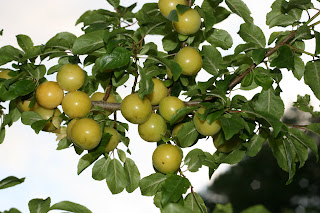So to recap, the Cherry-Plum jam is gorgeous and sadly nearly all gone already, hopefully we can make more next year. The bottling didn't happen, but we've frozen loads instead and they make really good crumbles.
More raised beds are being constructed as this is proving to be the ideal way of working with the heavy loam we have here. One of my earliest raised beds has now been established about four years. This year I grew parsnips in it and for the first time ever had roots that were difficult to dig because of their length. The nature and depth of the top-soil has changed dramatically having had no compaction from foot or wheel and only minimal cultivation over that time. It looks like 'Reduced Dig' could be a workable technique IF and only IF I keep off the land and that means raised beds with paths! It also means that I don't waste compost on ground that isn't growing crops, but that is another story.
 Last and definitely not least, today I want to brag about my cloches, which is where this blog started.
Last and definitely not least, today I want to brag about my cloches, which is where this blog started.Three weeks ago I pricked out some spring cabbage into a newly made bed and covered them with the glass barn cloches. Unfortunately the last plant in each row wasn't covered. However that has proved useful in demonstrating the advantages of protected cropping over unprotected. The cabbages under the cloches have grown on well, whilst those left outside have not really grown at all, and the weather has not been that bad yet! Oh yes, the white powder is a bit of lime, the slugs don't like crossing it and helps protect the plants whilst they are young.
Well hopefully the photo will show the difference between protected (top) and not (bottom).
Thanks for the visit, I'll endeavor to write more often and get some more pics up soon. Richard











